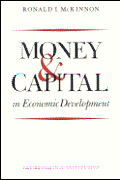Studies in this week’s Hutchins Roundup find nearly 40% of small businesses reported access to capital a major COVID-19 challenge, foreign investment leads to technology spillovers in investors’ countries, and more.
Want to receive the Hutchins Roundup as an email? Sign up here to get it in your inbox every Thursday.
Small businesses cite access to financing as major COVID-19 challenge
In an April survey of more than 66,000 small business owners and employees, conducted via Facebook, Georgij Alekseev of NYU’s Stern School and co-authors explore the impact of the COVID-19 shock on operations, employment, and financing. The biggest challenge—reported by nearly 40% of businesses—was access to capital. While 78% of businesses were concerned about their cash flows for the spring, only a quarter could access formal sources of financing, and most relied on informal or personal sources of saving. Access to loan and credit guarantees, alongside salary subsidies and tax deferrals, were the most popular policy proposals among respondents. The authors note pervasive gender disparities in the responses. Older and larger, but also majority-male, businesses were more likely to be open and more optimistic about their survival. Female employers and employees reported greater effects of the pandemic on their work, particularly with regards to balancing caretaking and household responsibilities, and women were more likely to quit their jobs in response to school closures.
Foreign investment is associated with similar technological innovation in the investor’s country
Foreign venture capital investment can help otherwise unfunded domestic firms succeed—but when the technologies are in critical areas such as artificial intelligence, fintech, and robotics, foreign investment has the potential to launch the U.S. into economically and militarily detrimental arms races, says Ufuk Akcigit of the University of Chicago and co-authors. Using data from foreign investments in U.S. companies between 1976 and 2015, the authors find that when there is foreign investment in a U.S. company, the investor’s country sees an increase in patent applications in similar technology and in citations of the U.S. start-ups’ patents. These “knowledge flows” are larger in patents subject to government secrecy orders. Moreover, the larger the technology gap between the U.S. and a given country, the more that country invests in the technology. But foreign investment also is associated with more patents generated by the U.S. startup. The authors conclude that, when weighing the merits of foreign investment, the U.S. government should consider both the benefits to U.S. innovation and the potential economic and military consequences of technology spillovers to other countries.
New measure finds almost 8% of workers in U.S. work more than one job
Keith A. Bailey and James R. Spletzer of the Census Bureau use the Longitudinal Employer-Household Dynamics (LEHD) survey data to measure multiple jobholding and find that 7.8% of workers in the U.S. are multiple jobholders and this rate has been trending upward over the past 20 years. The estimate is about 2 percentage points higher than the widely cited Current Population Survey (CPS) measure. The new measure counts individuals as multiple jobholders if, based on unemployment insurance records in the LEHD, they held at least one job consistently over three quarters and held one or more additional jobs within the same period; the CPS relies on a combination of survey responses and point in time evidence of wages. The authors note that while differences in definitions and reference periods (quarterly vs. monthly) explain the different levels of multiple jobholding, they do not explain the different trends. Moreover, the new measure is strongly cyclical, increasing during expansions and decreasing in contractions; the CPS-based measure is not cyclical. Using the new data, the authors find women and younger people are more likely to hold multiple jobs. In addition, they find that multiple job holding occurs across income groups and second or third jobs account for 25% or more of multiple jobholders’ incomes.
Chart of the week: Federal Debt as a percent of GDP is rising
Source: Congressional Budget Office
Quote of the week:
“I think financial conditions are very accommodative, unless you’re a small business or mid-size business in a person-to-person contact industry. I think we could do more. I think we should continue to look at whether there’s more that can be done there. The challenge on that is, we’re lenders not spenders. If we’re going to do more on, say, Main Street to make that a more accessible program, that’s more of a decision for Treasury and Congress than the Fed, because it’s going to involve taking greater risk of losses. But I do think looking at that will be appropriate,” says Robert Kaplan, President of the Federal Reserve Bank of Dallas.
The Brookings Institution is committed to quality, independence, and impact.
We are supported by a diverse array of funders. In line with our values and policies, each Brookings publication represents the sole views of its author(s).











Commentary
Hutchins Roundup: Small businesses, foreign investment, and more
September 24, 2020